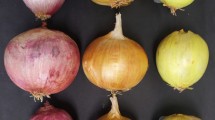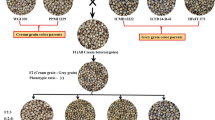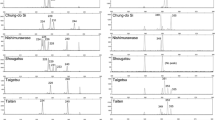Abstract
Bulb color in onions (Allium cepa) is an important trait and is inherited in a complex manner. However, the mechanism of color inheritance is poorly understood at the molecular level. A previous study showed that pink bulb color in onions is inherited as a single recessive trait. This trait is attributable to a significantly reduced transcription of the anthocyanidin synthase (ANS) gene. In this study, we developed a PCR-based marker for an allelic selection of the ANS gene to avoid the laborious progeny tests traditionally employed. To identify polymorphisms between pink and red alleles of the ANS gene, promoter sequences of both alleles were isolated. There was 97% nucleotide sequence identity between the promoter sequences of the two alleles. A 390-bp insertion was identified 632 bp upstream from the putative transcription start site in the pink allele. A pair of primers was designed on the flanking sequences of the inserted region and utilized as a PCR-based marker for allelic selection of the ANS gene. The reliability of the marker was tested using parents, F1 hybrids, and F3 lines whose genotypes had been identified by progeny tests. The marker was also used to evaluate the distribution of the pink allele in white and yellow breeding lines. The results indicated that a majority of the breeding lines tested were homozygous recessive.




Similar content being viewed by others
References
Arru L, Faccini N, Govoni C, Cattivelli L, Pecchioni N, Delogu G, Stanca AM, Vale G (2003) The PCR-based marker MWG2018 linked to the RDG2A leaf stripe resistance gene is a useful tool for assessing barley resistance in breeding programs. Crop Sci 43:1036–1042
Bastianetto S, Quirion R (2002) Natural extracts as possible protective agents of brain aging. Neurobiol Aging 5687:1–7
Bharti A, Khurana J (2003) Molecular characterization of transparent testa (tt) mutants of Arabidopsis thaliana (ecotype Estland) impaired in flavonoid biosynthesis pathway. Plant Sci 165:1321–1332
Braca A, Sortino C, Politi M, Morelli I, Mendez J (2002) Antioxidant activity of flavonoids from Licania licaniaeflora. J Ethnopharmacol 79:379–381
Bradeen JM, Simon PW (1998) Conversion of an AFLP fragment linked to the carrot Y2 locus to a simple, codominant, PCR-based marker form. Theor Appl Genet 97:960–967
Clarke AE, Jones HA, Little TM (1944) Inheritance of bulb color in the onion. Genetics 29:569–575
Cook NC, Samman S (1996) Flavonoids—Chemistry, metabolism, cardioprotective effects, and dietary sources. Nutr Biochem 7:66–76
Davis GN, El-Shafie MW (1967) Inheritance of bulb color in the onion (Allium cepa L.). Hilgardia 38:607–622
Endt DV, Kijne JW, Memelink J (2002) Transcription factors controlling plant secondary metabolism: what regulates the regulators? Phytochemistry 61:107–114
Falconer DS, Mackay TFC (1996) Introduction to quantitative genetics. Longman, UK, pp 1–47
Fossen T, Andersen OM, Ovstedal DO, Pedersen AT, Raknes A (1996) Characteristic anthocyanin pattern from onions and other Allium spp. J Food Sci 61:703–706
Fuleki T (1971) Anthocyanins in red onion, Allium cepa. J Food Sci 36:101–104
Goodrich J, Carpenter R, Coen ES (1992) A common gene regulates pigmentation pattern in diverse plant species. Cell 68:955–964
Holton TA, Cornish EC (1995) Genetics and Biochemistry of anthocyanin biosynthesis. Plant Cell 7:1070–1083
Itoh Y, Higeta D, Suzuki A, Yoshida H, Ozeki Y (2002) Excision of transposable elements from the chalcone isomerase and dihydroflavonol 4-reductase genes may contribute to the variegation of the yellow-flowered carnation (Dianthus caryophyllus). Plant Cell Physiol 43:578–585
Keli S, Hertog M, Feskens E, Kromhout D (1996) Flavonoids, antioxidant vitamins and risk of stroke. The Zutphen study. Arch Intern Med 156:637–642
Kim S, Binzel ML, Yoo KS, Park S, Pike LM (2004a) Pink (P), a new locus responsible for a pink trait in onions (Allium cepa) resulting from natural mutations of anthocyanidin synthase. Mol Gen Genomics 272:18–27
Kim S, Binzel M, Yoo K, Park S, Pike L (2004b) Inactivation of DFR (Dihydroflavonol 4-reductase) gene transcription results in blockage of anthocyanin production in yellow onions (Allium cepa). Mol Breed 14:253–263
King JJ, Bradeen JM, Bark O, McCallum JA, Havey MJ (1998) A low-density genetic map of onion reveals a role for tandem duplication in the evolution of an extremely large diploid genome. Theor Appl Genet 96:52–62
Knekt P, Jarvinen R, Reunanen A, Maatela J (1996) Flavonoid intake and coronary mortality in Finland: a cohort study. Br Med J 312:478–481
Kobayashi T, Nakata T, Kuzumaki T (2002) Effect of flavonoids on cell cycle progression in prostate cancer cells. Cancer Lett 176:17–23
Li J, Ou-Lee T, Raba R, Amundson R, Last R (1993) Arabidopsis flavonoid mutants are hypersensitive to UV-B irradiation. Plant Cell 5:171–179
Mienie CMS, Fourie H, Smit MA, Van Staden J, Botha FC (2002) Identification of AFLP markers in soybean linked to resistance to Meloidogyne javanica and conversion to sequence characterized amplified regions (SCARs). Plant Growth Regul 37:157–166
Quattrocchio F, Wing JF, Leppen HTC, Mol JN, Koes RE (1993) Regulatory genes controlling anthocyanin pigmentation are functionally conserved among plant species and have distinct sets of target genes. Plant Cell 5:1497–1512
Reiman GH (1931) Genetic factors for pigmentation in the onion and their relation to disease resistance. J Agric Res 42:251–278
Rhodes MJC, Price KR (1996) Analytical problems in the study of flavonoid compounds in onions. Food Chem 57:113–117
Shirley BW (1996) Flavonoid biosynthesis: “new” functions for an “old” pathway. Trends Plant Sci 1:377–382
Spelt C, Quattrocchio F, Mol JN, Koes RE (2000) anthocyanin1 of Petunia encodes a basic helix–loop–helix protein that directly activates transcription of structural anthocyanin genes. Plant Cell 12:1619–1631
Yamazaki M, Makita Y, Springob K, Saito K (2003) Regulatory mechanisms for anthocyanin biosynthesis in chemotypes of Perilla frutescens var. crispa. Biochem Eng J 14:191–197
Zeback R, Dressler K, Hess D (1989) Flavonoid compounds from pollen and stigma of Petunia hybrida: inducers of the vir region of the Agrobacterium tumefaciens Ti plasmid. Plant Sci 62:83–91
Acknowledgements
The authors thank members of Vegetable and Fruit Improvement Center for their dedicated support of this research. This work was supported by produce industry member contributions to the Vegetable and Fruit Improvement Center and US Department of Agriculture grant (CSREES 2001-34402-10543, “Designing Foods for Health”).
Author information
Authors and Affiliations
Corresponding author
Additional information
Communicated by H.C. Becker
An erratum to this article can be found at http://dx.doi.org/10.1007/s00122-005-1986-8
Rights and permissions
About this article
Cite this article
Kim, S., Yoo, KS. & Pike, L.M. Development of a co-dominant, PCR-based marker for allelic selection of the pink trait in onions (Allium cepa), based on the insertion mutation in the promoter of the anthocyanidin synthase gene. Theor Appl Genet 110, 628–633 (2005). https://doi.org/10.1007/s00122-004-1884-5
Received:
Accepted:
Published:
Issue Date:
DOI: https://doi.org/10.1007/s00122-004-1884-5




